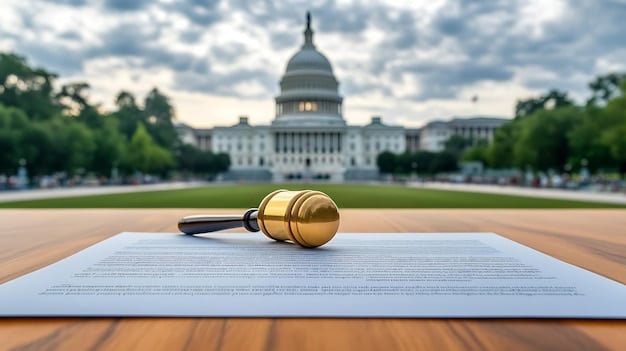Congress Debates New Legislation on Student Loan Forgiveness

Congress is currently engaged in intensive debates regarding new legislation aimed at addressing student loan forgiveness, with various proposals on the table to ease the burden on borrowers.
The Congress Debates New Legislation on Student Loan Forgiveness, addressing a pressing concern for millions of Americans burdened by student debt. The ongoing discussions aim to find viable solutions to alleviate the financial strain on borrowers.
Understanding the Student Loan Crisis
The student loan crisis in the United States has reached critical levels, affecting millions of individuals and families. Understanding the scope and impact of this crisis is essential to grasp the importance of the proposed legislation.
The Magnitude of Student Debt
Student debt in the United States has surged over the past few decades, now totaling over $1.7 trillion. This staggering figure impacts not only individual borrowers but also the broader economy.
- Total Debt: Exceeds $1.7 trillion, making it one of the largest forms of household debt.
- Number of Borrowers: Over 45 million Americans are currently burdened with student loan debt.
- Average Debt: The average student loan debt is around $37,000 per borrower.
- Default Rates: Significant portions of borrowers struggle to repay their loans, leading to high default rates.
Impact on Borrowers
The burden of student loan debt impacts borrowers in various ways, affecting their financial stability and future opportunities. Many graduates find themselves delaying major life decisions due to their debt obligations.

These include:
- Delayed Homeownership: Many graduates postpone buying homes due to their debt.
- Reduced Savings: Student loan payments often reduce the ability to save for retirement or other investments.
- Career Choices: Some borrowers are forced to choose higher-paying jobs over careers they are passionate about.
- Credit Scores: Missed payments can negatively impact credit scores, affecting future borrowing opportunities.
In conclusion, the student loan crisis is a multifaceted issue with significant economic and personal consequences. Addressing this crisis through legislative action is crucial to provide relief to borrowers and stimulate economic growth.
Key Proposals in Congress
Several key proposals are currently under consideration in Congress to address student loan forgiveness. These proposals vary in scope and eligibility requirements, each with its potential benefits and drawbacks.
The Biden Administration’s Plan
President Biden has proposed a student loan forgiveness plan that would provide up to $20,000 in debt relief for Pell Grant recipients and up to $10,000 for other borrowers. This plan aims to provide immediate relief to a large segment of the population.
- Pell Grant Recipients: Eligible for up to $20,000 in debt forgiveness.
- Other Borrowers: Eligible for up to $10,000 in debt forgiveness.
- Income Cap: The plan includes an income cap, limiting eligibility to individuals earning less than $125,000 per year.
- Legal Challenges: The plan has faced legal challenges, with opponents questioning the administration’s authority to implement such broad debt relief.
Congressional Proposals
In addition to the Biden administration’s plan, several members of Congress have introduced their own legislative proposals to address student loan forgiveness. These proposals range from targeted relief to broader, more comprehensive solutions.
- Targeted Relief: Some proposals focus on providing relief to specific groups, such as public service employees or those in high-need professions.
- Comprehensive Solutions: Other proposals aim to overhaul the student loan system, addressing issues such as interest rates and repayment options.
- Bipartisan Support: While student loan forgiveness remains a contentious issue, some proposals have garnered bipartisan support.

Ultimately, the various proposals in Congress reflect differing perspectives on how to best address the student loan crisis. The ongoing debates will shape the future of student loan policy and the financial well-being of millions of Americans.
Arguments For and Against Loan Forgiveness
The debate over student loan forgiveness is highly contentious, with strong arguments both for and against the policy. Understanding these arguments is crucial to assessing the potential impact of any proposed legislation.
Arguments in Favor
Supporters of student loan forgiveness argue that it would provide much-needed relief to borrowers, stimulate the economy, and address systemic inequalities. They contend that forgiving student debt would have far-reaching positive effects.
Here are some main points
- Economic Stimulus: Forgiveness would free up borrowers’ disposable income, leading to increased spending and economic activity.
- Reducing Inequality: Student loan debt disproportionately affects low-income and minority borrowers, exacerbating existing inequalities.
- Improved Mental Health: Alleviating the burden of student debt can reduce stress and improve borrowers’ mental health.
- Boosting Homeownership: Forgiveness would enable more graduates to purchase homes, contributing to the stability of the housing market.
Arguments Against
Opponents of student loan forgiveness raise concerns about fairness, cost, and the potential for moral hazard. They argue that forgiving student debt would set a dangerous precedent and shift the burden onto taxpayers.
Some of their reasons:
- Fairness Concerns: Critics argue that forgiveness is unfair to those who have already repaid their loans or chose not to attend college.
- Cost to Taxpayers: Student loan forgiveness would require a significant investment of taxpayer dollars.
- Moral Hazard: Some argue that forgiveness could encourage future borrowers to take on excessive debt, expecting it to be forgiven.
- Inflationary Effects: There are concerns that forgiveness could lead to inflation by increasing demand without a corresponding increase in supply.
Potential Economic Impacts
The potential economic impacts of student loan forgiveness are a subject of intense debate among economists. Various models and analyses have yielded different conclusions, depending on the assumptions and methodologies used.
Short-Term Effects
In the short term, student loan forgiveness could provide a boost to the economy by increasing consumer spending and reducing financial stress for borrowers. This could lead to increased demand for goods and services.
Here are some benefits
- Increased Consumer Spending: Borrowers would have more disposable income.
- Reduced Financial Stress: Lowering the burden of debt improves well-being.
- Job Creation: Increased demand could encourage businesses to hire more workers.
Long-Term Effects
The long-term economic effects of student loan forgiveness are more complex and uncertain. Some economists argue that forgiveness could lead to higher interest rates and inflation, while others contend that it would boost long-term economic growth by improving human capital.
Aspects to consider:
- Interest Rates: Forgiveness could potentially lead to higher interest rates if it increases the overall level of debt in the economy.
- Inflation: Increased demand without a corresponding increase in supply could lead to inflation.
- Human Capital: Forgiveness could encourage more people to pursue higher education, leading to a more skilled workforce.
In conclusion, assessing the economic impacts of student loan forgiveness requires careful consideration of both short-term and long-term effects. The ultimate outcome will depend on various factors, including the specific details of the forgiveness plan and the overall economic climate.
Legal and Political Challenges
Student loan forgiveness has faced numerous legal and political challenges, highlighting the complexities and sensitivities surrounding this issue. These challenges could significantly impact the implementation and effectiveness of any proposed legislation.
Legal Challenges
Several legal challenges have been filed against the Biden administration’s student loan forgiveness plan, arguing that the administration lacks the authority to implement such broad debt relief. These challenges raise important questions about the separation of powers and the scope of executive authority.
They address:
- Separation of Powers: The Constitution assigns legislative authority to Congress, raising questions about whether the executive branch can unilaterally forgive student debt.
- Administrative Procedure Act: Challenges have also been raised under the Administrative Procedure Act, arguing that the administration failed to follow proper procedures in implementing the plan.
- Standing: Courts must determine whether the plaintiffs in these cases have standing to sue, meaning they have suffered a direct and concrete injury as a result of the plan.
Political Challenges
Student loan forgiveness has also faced significant political challenges, reflecting deep divisions among lawmakers and the public. These divisions make it difficult to achieve bipartisan consensus on any proposed legislation.
Here’s what Congress is dealing with:
- Partisan Divide: Democrats generally support student loan forgiveness, while Republicans tend to oppose it.
- Public Opinion: Public opinion on student loan forgiveness is divided, with varying levels of support depending on the scope and eligibility requirements of the plan.
- Legislative Process: Overcoming these political challenges will require compromise and negotiation among lawmakers.
Navigating these legal and political challenges is crucial to ensure that any student loan forgiveness plan is both legally sound and politically sustainable.
Alternative Solutions and Reforms
In addition to student loan forgiveness, various alternative solutions and reforms have been proposed to address the student loan crisis. These solutions aim to improve the affordability and accessibility of higher education.
Income-Driven Repayment Plans
Income-driven repayment (IDR) plans allow borrowers to repay their loans based on their income and family size. These plans can provide relief to borrowers with low incomes, but they often come with complex rules and requirements.
Aspects of IDR plans:
- Income-Based Repayment: Payments are calculated based on a percentage of the borrower’s discretionary income.
- Loan Forgiveness: After a certain number of years, the remaining balance is forgiven (though this may be subject to taxation).
- Complexity: Navigating IDR plans can be challenging, with complex rules and requirements that vary depending on the plan.
Reducing the Cost of College
Efforts to reduce the cost of college include increasing funding for grant programs, capping tuition rates, and encouraging innovation in higher education. Making college more affordable can help prevent future student loan debt.
Some suggestions:
- Increased Grant Funding: Increasing funding for Pell Grants and other grant programs can help low-income students afford college.
- Tuition Caps: Some states have implemented tuition caps to limit the amount that public colleges and universities can charge.
- Innovation in Education: Encouraging the development of new educational models, such as online learning and competency-based education, can help reduce costs.
By focusing on both debt relief and systemic reforms, policymakers can address the student loan crisis from multiple angles, providing relief to current borrowers and preventing future debt accumulation.
| Key Point | Brief Description |
|---|---|
| 💰 Student Debt Crisis | Over $1.7 trillion in outstanding student loan debt in the US. |
| 🏛️ Congressional Proposals | Various plans, including the Biden plan, aiming to provide debt relief. |
| ⚖️ Arguments | Debates include economic stimulus vs. taxpayer burden. |
| 💡 Alternative Solutions | Income-driven repayment plans and efforts to reduce college costs. |
FAQ
▼
The main goal is to provide financial relief to borrowers burdened by student loan debt, aiming to stimulate the economy and reduce financial stress.
▼
Eligibility includes Pell Grant recipients who may receive up to $20,000 in forgiveness, and other borrowers may get up to $10,000, with income caps.
▼
Arguments against forgiveness include concerns about fairness to those who repaid loans, the cost to taxpayers, and potential moral hazards for future borrowing.
▼
It could boost consumer spending in the short term while debates continue regarding long-term effects like inflation and interest rates.
▼
Alternative solutions include income-driven repayment plans, efforts to reduce college costs, and grant funding increases to offer more affordable education options.
Conclusion
As Congress Debates New Legislation on Student Loan Forgiveness, the nation watches intently, recognizing the profound implications for individuals, the economy, and the future of higher education. Ultimately, the path forward requires careful consideration, compromise, and a commitment to addressing the root causes of the student loan crisis, paving the way for a more equitable and sustainable system.





